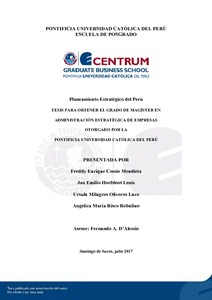| dc.contributor.advisor | D´Alessio Ipinza, Fernando Antonio | |
| dc.contributor.author | Cossio Mendieta, Freddy Enrique | es_ES |
| dc.contributor.author | Hoefsloot Lenis, Jan Emilio | es_ES |
| dc.contributor.author | Oliveros Lazo, Ursula Milagros | es_ES |
| dc.contributor.author | Risco Robalino, Angelica Maria | es_ES |
| dc.date.accessioned | 2017-07-18T15:28:51Z | |
| dc.date.available | 2017-07-18T15:28:51Z | |
| dc.date.created | 2017 | |
| dc.date.issued | 2017-07-18 | |
| dc.identifier.uri | http://hdl.handle.net/20.500.12404/9076 | |
| dc.description.abstract | El Perú, es un país con biodiversidad sin igual, casi todos los climas posibles, y una
geografía avasallante, es un pequeño mundo dentro del mundo. En los últimos 18 años, ha
logrado un crecimiento positivo del producto bruto interno, en promedio 4.0%, lo que ha
permitido la reducción de la pobreza extrema a un 5.0%. Asimismo, es uno de los países en
América Latina con mayor crecimiento económico que ha demostrado apertura comercial, a
través de diversos tratados y/o alianzas, como la del Pacífico; que le han permitido generar
oportunidades de exportación de productos no tradicionales e importaciones para el
desarrollo tecnológico del país en condiciones favorables.
El Perú, en el mediano plazo, tiene como objetivo ser un miembro pleno de la OCDE,
para lo cual viene trabajando en el fortalecimiento de sus instituciones y mecanismos de
simplificación administrativa, para una efectiva ejecución del gasto público. Sin embargo, el
escándalo de corrupción en Brasil, con impacto en diversos países del globo, inclusive al
Perú, que involucra a organismos del Estado peruano, sumado a las consecuencias de los
recientes desastres naturales y el alto ruido político entre el Poder Ejecutivo y Legislativo,
viene afectando las expectativas de crecimiento, estimándose que en 2017 será sólo un 2.0%.
Por otra parte, el contexto político internacional, vinculado a tendencias proteccionistas de
Estados Unidos, la decisión de China de un crecimiento económico moderado y sostenible,
así como el proceso de salida de Gran Bretaña de la Unión Europea, hacen necesario que el
Perú adopte nuevas estrategias y decisiones para revertir la tendencia a la baja de su PBI.
Por ello, el presente planeamiento, propone una visión del Perú al 2030 y cuáles
deberán ser los objetivos de largo plazo a alcanzarse, las estrategias a emplear, las políticas,
las acciones de corto plazo, la nueva organización, sus valores y código de ética; para
transformar sus ventajas comparativas en ventajas competitivas, logrando así ser un país
competitivo, líder en América Latina y con alto progreso social | es_ES |
| dc.description.abstract | Peru is a country with unequaled biodiversity, with almost all possible climates, and
an overwhelming geography, it is a small world within the world. In the last 18 years, it has
achieved a positive growth with its gross domestic product, with an average of 4.0%, which
has allowed the reduction of extreme poverty to an astonishing 5.0%. It is also one of the
countries with the highest economic growth in Latin America that has shown commercial
openness, through various treaties / alliances, such as the Pacific alliance; which has allowed
it to generate opportunities to export non-traditional products, and imports for the country's
technological development under favorable conditions.
Peru aims to be a full member of the OECD, for which it has been working to
strengthen its institutions, and administrative simplification mechanisms for an effective
execution of public expenditure. However, the corruption scandal in Brazil, with an impact in
several countries of the globe, including Peru, involving agencies of the Peruvian State, in
addition to the recent consequences of natural disasters, and high political scandals between
the Executive and Legislative, is affecting the growth expectations, which has an estimating
expectancy for 2017 will only be a 2.0%. On the other hand, the international political
context, linked to protectionist tendencies of the United States, China's decision to moderate a
sustainable economic growth, and Great Britain leaving the European Union, makes it
necessary for Peru to adopt new strategies and decisions to reverse the downward trend of its
GDP.
For that, the present planning proposes a new vision for Peru by 2030 and what the
long-term objectives are to be achieved, what strategies are to be used, what polices, what are
the short-term actions, what will be the new organization, and what values and code of ethics,
will be needed to transform its comparative advantages into competitive advantages, thus
becoming a competitive country, leader in Latin America with high social progress | es_ES |
| dc.language.iso | spa | es_ES |
| dc.publisher | Pontificia Universidad Católica del Perú | es_ES |
| dc.rights | info:eu-repo/semantics/openAccess | es_ES |
| dc.rights.uri | http://creativecommons.org/licenses/by-nc-nd/2.5/pe/ | * |
| dc.subject | Desarrollo regional -- Perú | es_ES |
| dc.title | Planeamiento estratégico de Perú | es_ES |
| dc.type | info:eu-repo/semantics/masterThesis | es_ES |
| thesis.degree.name | Maestro en Administración Estratégica de Empresas | es_ES |
| thesis.degree.level | Maestría | es_ES |
| thesis.degree.grantor | Pontificia Universidad Católica del Perú. CENTRUM | es_ES |
| thesis.degree.discipline | Administración Estratégica de Empresas | es_ES |
| renati.discipline | 413307 | es_ES |
| renati.level | https://purl.org/pe-repo/renati/level#maestro | es_ES |
| renati.type | https://purl.org/pe-repo/renati/type#tesis | es_ES |
| dc.publisher.country | PE | es_ES |
| dc.subject.ocde | https://purl.org/pe-repo/ocde/ford#5.02.04 | es_ES |






